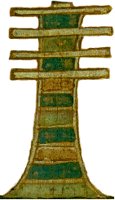
Djed Column
(djed)
Appearance: The djed is an Egyptian symbol that is depicted as a column with a broad base and capital. At the top of the column the capital is divided by four parallel bars. The image has been interpreted in several ways. It is said to be:
- four pillars, seen one behind the other
- a man's, or Osiris' backbone
- a Syrian cedar with its branches removed
- the pole around which sheaves of grain were tied
History: Osiris was originally an agricultural deity from Syria. When his followers immigrated to Egypt, they brought with them their fetish (cult object). Their fetish was the djed and they named their city after it, "Djedu". As the popularity of Osiris grew, so did the djed's appearance in art, especially in tombs. The djed was often painted on the bottom of coffins where the deceased's backbone would rest. The djed was also often created as an amulet of stability and regenerative power.
In Old Kingdom times, the djed was associated with the chief god of Memphis, Ptah, who was called the "Noble Djed."
The Djed Pillar Festival was a cultic celebration of the symbol and its powers. It was held annually in Egypt and was a time of great spiritual refreshment for the people. The priests raised the djed pillar on the first day of shemu (the season of harvest on the Nile). The people then paid homage to the symbol and conducted a mock battle between good and evil. Oxen were driven around the walls of the capital, honoring the founding of the original capital, Memphis.
Meaning: The djed column was the Egyptian symbol of "stability". It was the symbol of the tree that grew around Osiris's casket and was used as a pillar in a Byblos palace. The djed was considered necessary to aid in the transformation of human flesh into the spiritual form assumed by the deceased in eternity.
Digg This!
![]() Del.icio.us
Del.icio.us
![]() Stumble Upon
Stumble Upon
